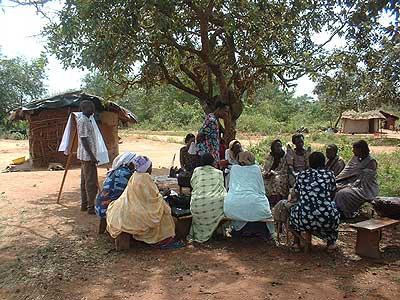


Baseline surveys in each of the three countries were preceded by a desk study. Secondary data were reviewed to help identify data gaps and to refine the survey design. The survey comprised both a quantitative and a qualitative part. Quantitative data on the dynamics of various livelihood components were collected through structured household interviews using a recall period of five years. In-depth interviews and focus group discussions using a variety of participatory tools were used to collect qualitative information.
During a focus group discussion in Uganda, widows discussed the labour constraints they experience due to the HIV/AIDS epidemic.

The surveys were conducted in the Lake Victoria Crescent agro-ecological zone in Uganda, the Ohangwena region in Namibia, and Southern Province in Zambia. Households from six sites per country were stratified according to gender and household type, and were then randomly selected from the different strata. In Uganda and Namibia, households were stratified first according to affected and non-affected status, and second by gender. A table summarizing the steps in the baseline studies and details of the methods employed in the respective studies appears as Annex I of this report. The operational definition of affected households used by the survey includes households with at least one member between 15 and 49 years old who is chronically ill or who died as a result of HIV/AIDS or related diseases (TB and pneumonia) during the recall period (1997-2002). In Zambia, households were stratified by gender (i.e. male- and female-headed households). Owing to respondents’ unwillingness to report cases of chronic illness and HIV/AIDS-related deaths in Zambia, a proxy indicator of the impact of the epidemic was used for disaggregated data analysis: i.e. caring for orphans, with orphans being defined as children up to 18 years old who have lost one or both parents through death. The final sample included 766 households in Zambia, 513 in Namibia and 610 in Uganda.
|
Glossary Female-headed households: households headed by a female who is 15 years or older. Male-headed households: households headed by a male who is 15 years or older. Foster orphan/child: a child who is living (fostered) in a household other than that of his or her parents. Orphan: a child up to 18 years of age who has lost one or both parents through death. Affected female-headed households: households that are headed by a woman (either widow or single mother) and have at least one member between 15 and 49 years of age who is chronically ill and/or died as a result of HIV/AIDS or related diseases (TB and pneumonia) during the recall period (1997-2002). Affected male-headed households: households that are headed by a man and have at least one member between 15 and 49 years of age who is chronically ill and/or died as a result of HIV/AIDS or related diseases (TB and pneumonia) during the recall period (1997-2002). Non-affected male-headed households: households that are headed by a man and have no members between 15 and 49 years of age who are chronically ill and/or died as a result of HIV/AIDS or related disease (TB and pneumonia) during the recall period (1997-2002). Non-affected female-headed households: households that are headed by a woman (either widow or single mother) and have no members between 15 and 49 years of age who are chronically ill and/or died as a result of HIV/AIDS or related disease (TB and pneumonia) during the recall period (1997-2002). Male-headed households with orphans: households that are headed by a man and take care of their own orphaned children (i.e. mother died) and/or foster orphaned children, e.g. from relatives. Female-headed households with orphans: households that are headed by a woman and take care of their own orphaned children (i.e. father died) and/or foster orphaned children, e.g. from relatives. Male-headed households without orphans: households that are headed by a man and in which both the husband and wife are alive and no orphans/children from outside the household are being fostered. No extra burden is placed on these households in comparison with male-headed households with orphans. Female-headed households without orphans: households headed by a single woman and in which no orphans/children from outside the household are being fostered. |
|
[5] More detailed information
regarding the study methodology is presented in Annex 1. |